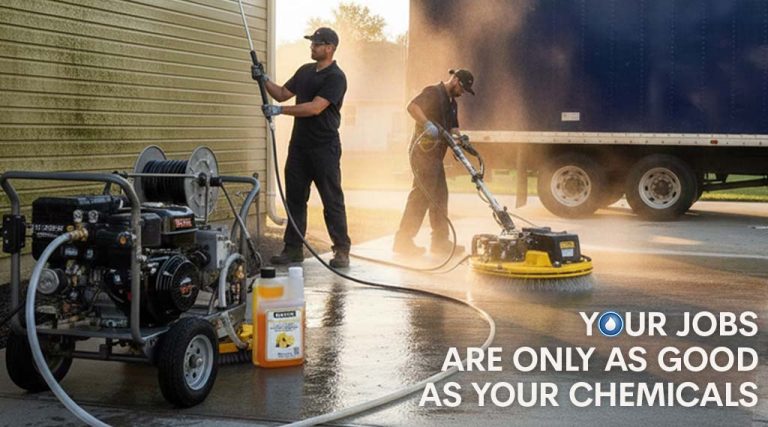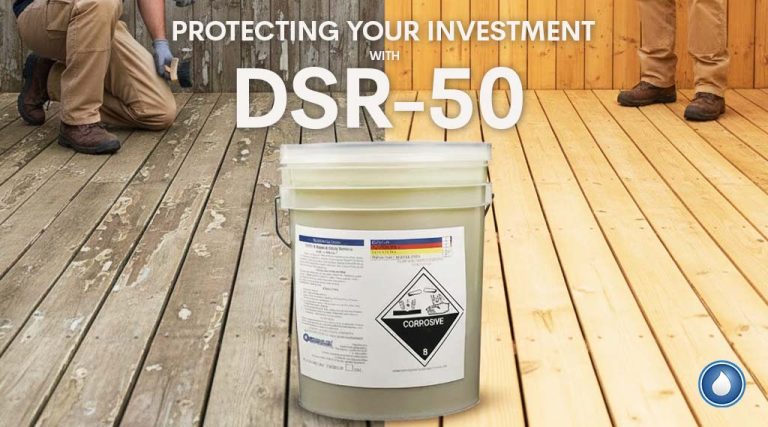- Home
- /
- PowerWash Industry
- /
- Chemical Application
Subscribe To Our Newsletter
Stay in the know on the latest products, deals, events, tips & tricks.
Social Media
Chemical Application
by Larry Hinckley
The application of chemicals is one of the longest standing controversies in the power washing industry. There are just as many opinions on which method is the correct method as there are chemical applicators. The one thing most contractors seem to agree on is that no single method will serve all circumstances efficiently. Of all the different methods, the three most often used are: 1) downstream chemical injection (after the pump), 2) upstream chemical injection (through the pump) and 3) chemical applicator pumps.
Each of these methods has their benefits as well as their limitations. Downstream chemical injection is most often used with cold pressure washers because of low cost and the ability to turn the chemical on and off at the wand. Upstream chemical injection is most often used with hot pressure washers because the ability to apply chemicals with hot water makes them more effective. Chemical application pumps are used when the chemicals are not compatible with the pressure washer. This article will examine the pros and cons of each of these methods.
Downstream Chemical Injection
The use of a downstream injector is the most common chemical application method in the power wash industry. These injectors are coupled in-line and operate on water power. The water velocity creates the needed vacuum (venturi) to draw the chemical and mix it with the water flow. The water velocity is regulated by changing the size of the discharge orifice. This is most often accomplished using a roll over valve, a double nozzle head or a dual lance wand.
Most manufacturers of these injectors claim that their draw rates are from 10% to 20%. With a few exceptions, I have found this to be accurate. However, many people are requesting a draw rate in excess of 50%, which is only available with an injector that is especially designed to fit at the end of a spray lance. There are a couple of problems with this type of injector. One problem is high cost. Also, due to the location, it’s a cumbersome package to handle for some applications. The contractors who most commonly request higher draw rates are ones who are applying chlorine to exterior surfaces such as buildings, decks and fences. The reason for their concern is that the strongest concentrate of sodium hypochlorite (chlorine) available is 15%. When this is mixed at a 10% to 20% ratio in the injector, many people feel that it is too weak to adequately clean and remove mildew. Because of this, some contractors have questioned the advisability of using chlorine as a cleaning agent to begin with. We could pursue this to infinity and never reach a consensus.
Another problem with this type of injector is due to the restriction created in the ¼” pressure hose that is used as an integral part of the telescoping wand. In most cases, a downstream injector will not work with a ¼” pressure hose. This is because the ¼” hose creates too much restriction and reduces the water flow (increases the back pressure) causing the injector not to work.
Other things that can inhibit the flow of water, thereby decreasing velocity and stopping the vacuum that is required to draw chemical, are: 1) using a discharge hose in lengths of 200 feet or more, 2) installing the injector before the hose reel, water heater or other restrictive devices and 3) using certain types of trigger guns that are too restrictive.
One advantage of downstream injection is that you will use less chemical. On the downside, you will clean slower because you will be applying the chemical with low pressure and rinsing with high pressure. With upstream injection, you will apply your soap as you are washing on high pressure and rinse on high pressure as well. You will use more chemical this way, but you will clean faster and more thoroughly.
Another advantage of downstream injection is that it allows the operator to turn the chemical draw on and off from the gun. Upstream injection requires that the operator return to the machine in order to turn the chemical on and off. As you can see, downstream injection can save many steps and a lot of time over the course of a day.
Another major benefit of downstream injection is that you can use chemicals that are corrosive in nature (like acids) because they never enter the pump, unloader valve or heater coils.
Upstream Chemical Injection
Upstream chemical injection is acheieved by restricting the inlet water to the pump. High pressure pumps used on hot high pressure washers can pull a vacuum. Therefore, these pumps do not have to be pressure fed, and they have the ability to draw water and chemicals from water tanks and chemical tanks. The vacuum is created either with a restrictor barb or with gate valves in the inlet plumbing to the pump. The operator must return to the pressure washer to turn the chemical on and off with a metering valve.
One of the advantages of this type of unit is that any strength of chemical can be mixed with the inlet water. However, the chemical (usually a heavy-duty alkaline detergent) must be compatible with the components in the pressure washer. Most quality, high pressure washer detergents are compatible with the internal parts of a pressure washer.
Chemical Applicator Pumps
The two types of chemical applicator pumps that are most commonly used in the mobile power wash industry are compressed air sprayers {pump-up style} and electrical diaphragm pumps.
Pump-up sprayers are often used because of their low cost. The mobile power wash industry is probably one of the least expensive fields of endeavor in which you can start and successfully run a business. Therefore, you will find many people searching for cheap answers to expensive problems. Contractors in our field are some of the most inventive people that you will ever meet. Pump-up sprayers are an inexpensive answer to an expensive problem that they face regularly.
There are different styles and makes of these pump-up sprayers ranging in price from $14 to $145. The lower priced sprayers are the kind you would find in a garden shop or hardware store. They are designed for homeowner use. The higher priced sprayers are the ones you might find at a contractor supply or a pressure washer distributor. Some of the advantages of the higher-end sprayers would be better construction, viton seals and diaphragms, stainless steel, corrosion-resistant tanks or wetted parts and epoxy-coated steel. You will find all makes and models in use within the industry, but most often you will find the medium priced sprayers being used because they offer some longevity without the extreme expense. Some people won’t use any other type of sprayer because they really prefer this method, but generally, they have chosen this method for economic reasons.
Pump-up sprayers are available for spraying everything from acid to deck sealer. Although repair parts are available for these types of sprayers, in many cases they are not worth rebuilding, depending upon the initial cost of the sprayer. When nothing else fits your budget, they can be quite useful. I have used these types of sprayers and found that for small jobs, they are tough to beat. You can be in and out in less time than it takes to clean up a larger, more sophisticated unit.
The electrical pumps most often used are self-priming, positive displacement pumps driven by permanent magnet motors. They utilize a heavy-duty, ball bearing/offset cam assembly, which drives a reciprocating two-piston plate. A diaphragm is clamped between the inner and outer pistons, thus sealing the pumping chamber. When actuated, it creates an alternating suction and pressure condition that opens and closes the inlet and outlet check valves.
Electrical pumps will have either an internal bypass system or an on demand system. These pumps are available in 12 volt DC, 120 volt AC and 240 volt AC powered models. The diaphragm that should be used for corrosive materials is made of viton because it is the most resistant to the type of chemicals used in the power wash industry. You will also need to use a valve assembly with viton parts. This will be incorporated in the new pump that you purchase when you specify the use is for corrosives.
These pumps are available in different output volumes (expressed in gallons per minute). These volumes will range from ½ to 6 gallons per minute. The size that you would choose would be directly related to the type of work that you are doing. Obviously if you were applying aluminum brightener to a truck, you would not want to use a 5 gpm pump. Nor would you want to use a ½ gpm pump to apply deck brightener when preparing it to be sealed.
In choosing the appropriate pump for your specific needs, some of the things that you should consider are the availability of electricity, the type of electricity available and the kind of chemicals to be applied. One of the more popular pumps used in the industry is the 12 volt model. This is because, even if you don’t have a heavy duty charging system on your pressure washer and a large storage battery, you probably do have some sort of vehicle with a 12 volt charging system that you can attach it to. This means that you can be totally self reliant without the added expense of a power generator. The 120 volt AC model is more popular to the contractor who will be working in areas where this type of power is readily available. Typically, you will find that these units are being used in kitchen grease exhaust cleaning, residential and industrial work where this type of power is readily available. The 240 volt pump is seldom used because this type of power is seldom found around a power wash job site. In my opinion, voltage this high would be excessively dangerous.
Electrical pumps will vary in price from $65 to $180 and are able to be rebuilt. If you are applying large amounts of chemical on a repetitive basis, this is definitely a method to consider. You can control the chemical mixture and the flow rate much better than most other ways of chemical application.
Conclusion
The chemical application methods I have discussed in this article are the ones most commonly used. There are many other ways of applying the chemicals that are used in this industry. When considering which method to use, it is important for you to understand how all of the methods work so that you can determine their value to your style of cleaning. It is a well established fact that chemical is cheaper than labor and that the best way to assure return business is to do the best job that you can.
Larry Hinkley is a Senior Technical Advisor for PowerWash.com of Fort Worth, TX.
The above article appeared in Cleaner Times and is used by permission. This article is also made available on the internet by Cleaner Times at
http://www.adpub.com/ctimes/features2/Chemicalapp.cfm?article=Chemical%20Application
Share This Post
More To Explore
2025 Tax Changes, New Rigs & Easy Payments: What Power Washing Pros Need to Know Before Dec 31
Updated for the latest federal guidelines. PowerWash.com does not provide tax advice. Always consult your CPA. As the year comes ...
Your Jobs Are Only as Good as Your Chemicals: Here Are the Ones That Stand Out
If your busy season has you running from job to job, you already know this: the equipment you use matters, ...
Stripping Wood the Smart Way (Not the Hard Way)
Deep Wood Restoration Made Simple with DSR-50 Whether you’re a professional deck and fence restoration contractor or a homeowner prepping ...
Fall Power Washing Tips: Get Your Last Cleaning Jobs Done Before Winter
Make the Most of Fall The Perfect Power Washing Season As temperatures cool and leaves start to fall, it’s the ...





